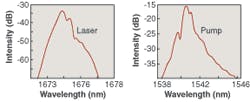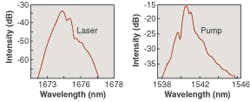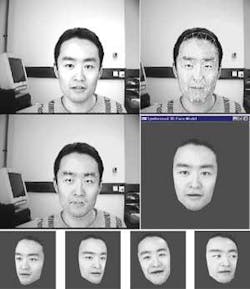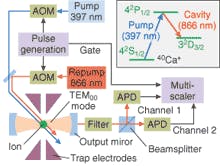Newsbreaks
Photonic A-to-D conversion directly samples multigigahertz signals
Researchers at HRL Laboratories (Los Angeles, CA) have combined photonic and indium phosphide heterojunction bipolar transistor (HBT) technologies to directly sample multigigahertz signals in analog-to-digital (A-to-D) conversion. Using photonic sampling, high-resolution A-to-D conversion of very high-frequency signals can be accomplished without using mixer cascades.
In the direct-sampling approach, a train of 10-GHz low-jitter picosecond optical pulses from a mode-locked laser is used in conjunction with an optical modulator to sample the analog input. A notable feature of optical sampling is its immunity from signal-induced jitter. Furthermore, the higher harmonics of the picosecond pulses can downsample the high-frequency analog input, creating low frequency signals that can be digitized with high resolution. Optoelectronic circuits 2 × 3 mm in size integrate photodetectors (for detecting the optically sampled signal) and continuous-time A-to-D conversion electronics that possess bandpass frequencies located at or near 1.8 GHz. Specifically, HRL demonstrated the photonic A-to-D conversion of 12-GHz signals with 10 bits of resolution (over a noise bandwidth of 1 MHz). Although the experiment was carried out only for analog inputs lying in the X-band, the same technology can be extended easily to digitize 12- to 50-GHz signals. Contact Willie Ng at [email protected].
Birefringent crystal measures electric field of mid-IR pulses
While most commonly used fast optical photodetectors measure only the intensity of a light pulse, methods exist for sampling the actual electric field of broadband terahertz waves, resulting in knowledge of both the amplitude and phase. Efforts are ongoing to push this capability into the mid-IR and even to the near-IR. When used as electro-optic samplers for this purpose, materials like zinc telluride and gallium phosphide severely distort the amplitude and phase spectra, limiting use at shorter wavelengths.
Researchers at the Universität Konstanz (Konstanz, Germany) and the Universität München (Garching, Germany) are exploiting birefringent gallium selenide (GaSe) crystals to get around this problem. Transients created in a first GaSe crystal by 10-fs pulses from a Ti:sapphire laser enter a second GaSe crystal, tiltable for phase matching. A nonlinear polarization-changing process in the crystal provides information over a dynamic range of 104. Pulses as short as 28 fs with a 3-dB bandwidth of 41 THz were measured; the center frequency of the detection could be tuned from 31 THz (10 µm) to the far IR, with frequency components beyond 120 THz (2.5 µm) observed. Contact Rupert Huber at [email protected].
First silicon laser is demonstrated
Crucial to the development of optical computers that process information using light instead of electrons, the first silicon laser has been demonstrated by researchers at the University of California, Los Angeles.
In the experiment, a tapered silicon-on-insulator rib waveguide with length of 2 cm and a total insertion loss of 0.8 dB was used as the gain medium. The waveguide was pumped with a 1540-nm laser fed into a wavelength-division multiplexer (WDM). A pulsed laser was used for pumping to minimize losses induced by free carriers generated by the photon-absorption process in silicon. Following the WDM and the waveguide, the 95%-transmission leg of a tap coupler was used to feed the signal back into a laser cavity formed by a fiber-ring configuration. A second WDM was placed at the output end from the 5% leg of the tap coupler just after the waveguide to separate the residual pump signal from the 1675-nm Raman-laser-signal wavelength generated within the waveguide (measured laser and pump spectra are shown). The measured Raman gain of the silicon laser was approximately 3.9 dB with a pump power of 9 W. Contact Bahram Jalali at [email protected].
Multilayer transparent electrode for displays is flexible
Many are familiar with enthusiastic descriptions of future flexible displays that will roll up as if they were window shades. Whether or not this degree of flexibility is soon achieved in practical form, flexible displays will have their place as durable, portable screens no thicker than cardboard. Currently, the layer that first fails under flexure is the transparent electrode layer. Indium tin oxide (ITO), the preferred transparent electrode for flat-panel displays, is too fragile in its usual form for next-generation flexible displays. Researchers at the MCNC Research & Development Institute (Research Triangle Park, NC) have developed a pliable alternative.
Although based on ITO, the new electrode is formed of a more-complex structure. A layer of silver is sandwiched between two 35-nm-thick layers of ITO; in the experiment, versions were fabricated with silver layers of 0, 4, 8, 12, and 15-nm thicknesses. The structures were deposited on either a 100-µm-thick polymer or thin glass substrate. All structures with some silver in them conducted better than ordinary ITO. After 10,000 cyclic bends to a 6-mm radius, the resistance of the new electrode increased by a factor of 1.22, compared to ordinary ITO’s increase of 7.4. In addition, flexible organic-light-emitting-diode displays fabricated with the new electrode performed more efficiently. Contact Jay Lewis at [email protected].
Entangled photon pairs synchronize distant clocks
Synchronization of geographically distant clocks is necessary to telecommunications and to the accuracy of global-positioning systems. Current methods for synchronization of distant clocks have limitations due to relativistic effects. But now, researchers from the University of Maryland (Baltimore, MD) have demonstrated synchronization with picosecond resolution of two clocks separated by 3 km based on the quantum feature of entangled photon pairs.
Entangled photons are generated in a continuous-wave-pumped spontaneous parametric downconversion of 458-nm laser light by an 8-mm lithium triborate crystal. The nonlinear interaction inside the crystal annihilates a high-frequency pump photon, producing two lower-frequency entangled photons that, at a distance of 3 km, show a natural time-correlation measurement uncertainty on the order of a picosecond. By sending a pair of entangled photons to separate photodetectors attached to two distant clocks, and then by switching the photons and sending them to opposite detectors, the time history records of the photons can be compared by a standard communications channel. A statistical sampling of the clock responses can be used to adjust the time differences and keep the clocks synchronized with picosecond resolution. Contact Alejandra Valencia at [email protected].
3-D faces are synthesized from single 2-D video frames
Much hype has surrounded the opening of the movie The Polar Express and its half-animated, half-live look, which is made possible by so-called “performance capture”-in which actors’ body motions and facial appearances are separately digitized and then recombined. At a more-mundane level, 3-D digital capture and synthesis of human faces can be valuable for applications ranging from security to video games. Researchers at the University of Surrey (Guildford, England) have developed a robust automatic 3-D technique that uses single 2-D video frames on complex backgrounds as the input data.
The image is first processed to remove the background, some hair, and other confusing features; head inclination is then determined and the data approximately fit to a generic face. Local-refinement algorithms concentrate on the chin, eyebrows, eyes, and mouth, adjusting the generic face to fit the actual face, moving vertices based on studies of muscle motion. The resulting 3-D synthesized face can be rotated in space and even made to look in different directions or smile. Contact Yun Sheng at [email protected].
Crystal orientation of lead-salt lasers affects gain
Although their output powers (typically less than 1 mW even at 77 K) are much less than that of gallium arsenide semiconductor lasers, lead-salt lasers have the advantage of easy and large current tuning, narrow linewidth, and longer wavelengths. Researchers at the School of Electrical and Computer Engineering at the University of Oklahoma (Norman, OK) have shown that lead-salt laser gain and performance is improved by selecting an optimum crystal orientation for growth of the laser structure.
Lead-salt lasers have traditionally been fabricated on lead-salt wafers with a crystal orientation of [100], due to easy cleaving of two parallel facets along the [100] cleavage plane. Simulations of edge-emitting lasers with [100] and [110] crystal orientations showed, however, that the [110]-oriented laser had a threshold five times lower at the same temperature and a roughly doubled output power when compared to the [100]-oriented laser. In addition to the simulations, the team fabricated lead selenide structures on a [110]-oriented barium fluoride substrate that supported its findings; the researchers anticipate that a [110]-oriented lead-salt laser will operate at above room temperature in a continuous-wave mode. Contact Zhisheng Shi at [email protected].
Ion-trap cavity repeatedly generates single photons
Controlled production of single photons is necessary to applications in quantum cryptography and information processing. Previous attempts using fluorescence of single emitters cause spontaneous generation of photons in an irreversible process and cannot be used as a bidirectional interface between atomic and photonic quantum states as required in a quantum network. In contrast, single-photon generation as the result of a coherent process has been achieved by researchers at the Max Planck Institute and the University of Munich (Garching, Germany), and the National Institute of Information and Communications Technology (Kobe, Japan).
In their experiment, a single calcium (40Ca+) ion is confined in a linear radio-frequency ion trap at the center of an optical resonator. The ion-trap cavity provides permanent and fully controllable coupling of the calcium particle to the field, ensuring that after a photon has been deposited in the cavity the ion occupies the metastable state with a one-second lifetime. Because this state is not coupled to the pump beam, no additional photons are generated until the ion is actively recycled to the ground state. During 3000 seconds of data taking, only 2 ± 13 two-photon events were recorded compared to 411,200 ± 335 single photons, demonstrating effective two-photon suppression. Contact Wolfgang Lange at [email protected].
High-power laser-diode bar reaches 71% wallplug efficiency
At the Lasers and Electro-Optics Society 2004 Annual Meeting (Nov. 7-11; Rio Grande, Puerto Rico), researchers at Alfalight Inc. (Madison, WI) presented results on 976-nm-emitting laser-diode bars that have reached record power-conversion efficiencies. Developed with support from the DARPA (Defense Advanced Research Projects Agency) SHEDS (Super High Efficiency Diode Sources) program, Alfalight demonstrated a 50-W, laser bar with 71% power-conversion efficiency (PCE) at 25°C and 73% efficiency at 10°C. Alfalight has thus achieved the Phase I SHEDS objective to deliver 65% PCE diode laser bars to DARPA by March 2005, and is now aiming at the 80% PCE targeted for September 2006 as part of SHEDS Phase II.
The Alfalight team achieved these high efficiencies by examining the various sources of loss in the laser and taking steps to remedy each one. Careful bandgap engineering increased the efficiency of carrier injection into the quantum well, the confinement structure was altered to decrease the laser’s operating voltage, and waveguide adjustments reduced the losses from scattering and absorption of lasing photons. Progressing toward the 80% SHEDS goal will likely incorporate more-aggressive techniques that confine the carriers in two or even three dimensions, further enhancing device efficiency. Contact Robert Williamson III at [email protected].



